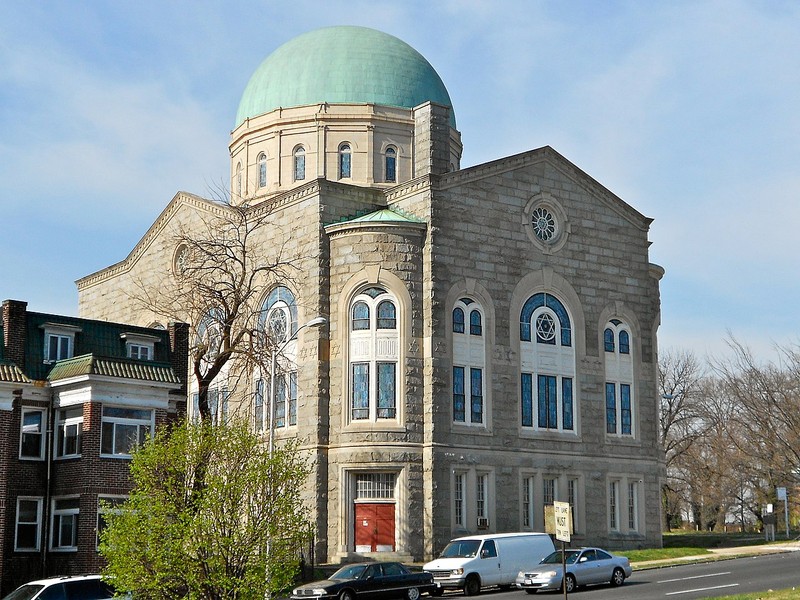Shaarei Tfiloh Synagogue
Introduction
Text-to-speech Audio
This striking building is the historic Shaarei Tfiloh Synagogue, which was built in 1921 and is one of the oldest continuously used Jewish temples in Maryland. Designed in the Classical Revival style, it is rectangular in shape and features inset rounded corners, large arched stained glass windows with the Star of David depicted in the glass and in wood panels, and a dome covered in copper that rests on a sixteen-sided base with arched windows. The sanctuary is located on the second level and features woodwork, an oak floor, and plastered walls and ceilings. Shaarei Tfiloh, which means "Gates of Prayer," is home to an Orthodox congregation established by Russian and Eastern European immigrants in 1920. It was added to the National Register of Historic Places in 1996.
Images
Built in 1921, Shaarei Tfiloh Synagogue is one of the oldest continuously used synagogues in Maryland. The makeup of the congregation in its early years consisted of primarily Russian and Eastern European Jews.

Backstory and Context
Text-to-speech Audio
The first European Jews to settle in Baltimore were primarily from Germany and began arriving in the mid-1800s. They established congregations in downtown and east Baltimore. Russian and Eastern European Jews started immigrating to America in the late 1800s and early 1900s. As a result, the Jewish population in Baltimore rose from around 10,000 to 65,000 between 1880 and 1920. Russian and Eastern European immigrants, who usually followed Orthodox Judaism, often established congregations in the synagogues built by previous congregations that relocated to the northwest part of the city by 1900. Eventually, these Orthodox congregations relocated there as well (it should be noted that deed covenants and real estate practices prevented Jews and other minorities from living in certain parts of the city).
New ones, including Shaarei Tfiloh which was incorporated in 1921, were also established in the area. Its members first met in a house just two blocks from where the synagogue now stands. Soon the congregation raised money to buy the property and hire the architect to design the building. Construction began on July 10, 1921 and was finished on September 23. The first service was held four days later.
Shaarei Tfiloh became an important social and religious center for the community. Its activities and programs included a Hebrew school, Boy and Girl Scout troops, speaker's forums, and teen discussion groups. The congregation's first rabbi, Nathan Drazin, wasn't hired until 1933 but he remained until 1969 when he moved to Israel. Under his tenure, Shaarei Tfiloh became the largest Jewish congregation in Baltimore and was usually the site of special ceremonies because its size could accommodate more people (it originally had over 2,000 seats; it now has 1,000).
After World War II, most Jewish congregations moved to the suburbs and African-American residents started to move into the area. The size of the congregation declined as well. Rabbi Drazub chose to not to move the congregation, however, despite the wishes of other leaders. Up until at least the mid-1990s, it was one of only four Jewish congregations in the city using synagogues built before 1930.
Sources
Bridwell, Lindsey. "A Miracle in Baltimore." June 4, 2015. Baltimore Jewish Times. June 4, 2015. https://www.jewishtimes.com/a-miracle-in-baltimore.
"Shaarei Tfiloh Synagogue." Synagogues360. Accessed July 28, 2022. https://synagogues-360.anumuseum.org.il/gallery/shaarei-tfiloh-synagogue.
Shoken, Fred B. "Shaarei Tfiloh Synagogue." National Park Service - National Register of Historic Places Nomination Form. October 10, 1996. https://npgallery.nps.gov/GetAsset/1ef1b4ab-673c-4026-8bf6-96a4cc13e38b.
Wikimedia Commons: https://commons.wikimedia.org/wiki/File:Shaarei_Tfiloh_Baltimore.JPG
